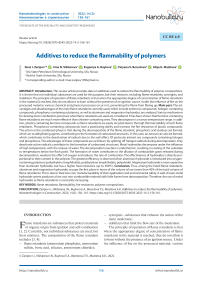Additives to reduce the flammability of polymers
Автор: Zaripov I.I., Vikhareva I.N., Buylova E.A., Berestova T.V., Mazitova A.K.
Журнал: Nanotechnologies in Construction: A Scientific Internet-Journal @nanobuild-en
Рубрика: The results of the specialists’ and scientists’ researches
Статья в выпуске: 2 Vol.14, 2022 года.
Бесплатный доступ
Introduction. This review article provides data on additives used to reduce the flammability of polymer compositions. It is shown that not individual substances are used for this purpose, but their mixtures, including flame retardants, synergists, and stabilizers. The principle of operation of flame retardants is that when the appropriate degree of concentration of flame retardants in the material is reached, they do not allow it to burn without the presence of an ignition source. Under the influence of fire on the processed material, various chemical and physical processes occur in it, preventing the flame from flaring up. Main part. The advantages and disadvantages of the main flame retardants currently used, which include antimony compounds, halogen-containing compounds, phosphorus-containing substances, as well as aluminum and magnesium hydroxides, are analyzed. Various mechanisms for slowing down combustion processes when flame retardants are used are considered. It has been shown that bromine-containing flame retardants are much more effective than chlorine-containing ones. They decompose in a narrow temperature range. In addition, plastics containing bromine compounds as flame retardants are easily recycled due to the high thermal stability of such flame retardants. Phosphorus-containing compounds have a plasticizing ability and increase the fire resistance of plastic compounds. The action in the condensed phase is that during the decomposition of the flame retardant, phosphoric acid residues are formed, which act as dehydrating agents, contributing to the formation of carbonized structures. In this case, an aerosol can also be formed, which contributes to the deactivation of radicals due to the wall effect. Of particular interest are compounds containing halogen and phosphorus. The advantages of these compounds are as follows: by splitting off halogen radicals during decomposition, they deactivate active radicals; contribute to the formation of carbonized structures. Metal hydroxides decompose under the influence of high temperatures with the release of water. The decomposition reaction is endothermic, resulting in cooling of the substrate to temperatures below the flash point. The formation of water contributes to the dilution of combustible gases released during decomposition, weakens the effect of oxygen and reduces the rate of combustion. The effectiveness of hydroxides is directly proportional to their content in the polymer. The greatest efficiency is observed when aluminum hydroxide is introduced into oxygencontaining polymers (polyethylene terephthalate, polybutylene terephthalate, polyamide). Magnesium hydroxide is more expensive than aluminum hydroxide, but has a higher heat resistance (up to 300оC). Conclusion. Thus, among the listed flame retardants, aluminum and magnesium hydroxides occupy the first place in terms of the volume of use (more than 40% of the total volume of flame retardants). This is due to their low cost, manufacturability of their application and environmental safety. A well-chosen metal hydroxide system produces a low-cost non-combustible material with little fumes from decomposition. Therefore, the use of metal hydroxides as flame retardants is constantly increasing.
Flame retardants, flammability, fire resistance, polymer compositions
Короткий адрес: https://sciup.org/142231197
IDR: 142231197 | DOI: 10.15828/2075-8545-2022-14-2-156-161
Список литературы Additives to reduce the flammability of polymers
- Maslova I.P. Chemical additives to polymers. Directory. Moscow: Chemistry; 1981.
- Aseeva R.M., Zaikov G.E. Reducing the combustibility of polymeric materials. Moscow: Knowledge; 1981.
- Weil E., Levchik S. Flame retardants for plastics and textiles. Practical use. Munich: Hanser Publishing House; 2009.
- Glikshtern M. V. Fire Retardants. Polymer Materials. 2003; 3: 22–23; 4: 15–18.
- Kopylov V.V. Polymeric materials with reduced flammability. Moscow: Chemistry; 1986.
- Gul V.E., Kuleznev V.N. Structure and mechanical properties of polymers. Moscow: Ed. Labyrinth; 1994.
- Aseeva R.M., Zaikov G.E. Combustion of polymeric materials. Moscow: Nauka; 1981.
- Baratov A.N., Andrianov R.A., Korolchenko A.Ya., Mikhailov D.S., Ushkov V.A., Filin L.G. Fire hazard of building materials. Moscow: Stroyizdat; 1988. 380 p.
- Kodolov V.I. Combustibility and fire resistance of polymeric materials. Moscow: Chemistry; 1976.
- Khalturinsky N.A., Berlin A.A., Popova T.V. Combustion of polymers and mechanisms of action of fire retardants. Uspekhi khimii. 1984; 53(2): 21.
- Kodolov V.I. Flame retardants of polymeric materials. Moscow: Chemistry; 1980.
- Plotnikova G.V., Egorov A.N. Available organophosphorus compounds as flame retardants. Fire and explosion safety. 2003; 6: 26–29.
- Fedeev S.S., Bogdanova V.V., Safropenko E.D. Inhibition of combustion of polymers. Study of the mechanism of action of synergistic mixtures of antimony oxide - halogen-containing compounds. Moscow; 1988.
- Levchik S.V. Introduction to Flame Retardancy and Polymer Flammability. Flame Retardant Polymer Nanocomposites. 2006; 1–29.
- Raffan-Montoya F., Stoliarov S.I. Measurement of heat release in laminar diffusion flames fueled by controlled pyrolysis of milligram-sized solid samples: Impact of bromine- and phosphorus-based flame retardants. Combustion and Flame. 2015; 162(12): 4660–4670.
- Shaklein A.A. et al. Two-step gas-phase reaction model for the combustion of polymeric fuel. Fuel. 2019; 255(115878).
- Snegirev A.Y. et al. Autocatalysis in thermal decomposition of polymers. Polymer degradation and stability. 2017; 137: 151–161.
- Berlin A.A. Combustion of polymers and low flammability polymeric materials. Soros Educational Journal. 1996; 9: 57–63.
- Kausar A. et. al. Recent Developments in Different Types of Flame Retardants and Effect on Fire Retardancy of Epoxy Composite. Polymer - Plastics Technology and Engineering. 2016; 55(14): 1512–1535.
- Kuleznev P.V., Balakin V.M. Investigation of the effect of phosphorus-containing fire retardants on the combustibility and dielectric properties of epoxy compounds. Plastic masses. 2012; 9: 8–9.
- Chaly V. P. Metal Hydroxides: Patterns of Formation, Composition, Structure, and Properties. Kyiv: Institute of General and Inorganic Chemistry of the Academy of Sciences of the Ukrainian SSR. Sciences. Dumka; 1972. 158 p.


